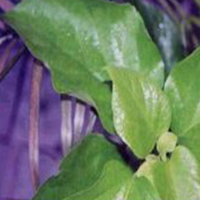Finding novel and natural ingredients to help support blood sugar levels is helpful to manage weight loss and your diet. One such ingredient is called Banaba Extract.
The insulin-like action of the active principles in the leaves, renders the extract potentially useful in nutritional supplements to support metabolism and healthy blood sugar levels, as well as in weight management formulations.

The active principle is colosolic acid (corosolic acid) which is 2a-hydroxyursolic acid. (2a, 3b-Dihydroxy-12-en-28-oic acid). Recent studies revealed that ellagitannins (lagestroemin, flosin B and reginin A) found in the leaf extract, also contribute to enhancing glucose transport2.
Quick Of Summary Banaba
- Colosolic acid was shown to stimulate glucose-transport at 1 mM2
- Hypoglycemic activity observed on oral administration of banaba extract to rats with alloxan-induced diabetes3
- Weight gain, adipose tissue weight, and glycated hemoglobin levels were lowered significantly in mice with banaba extract; hepatic lipid levels also decreased 35%4
- Banaba extract was found to enhance glucose uptake in adipocytes and inhibit preadipocyte differentiation5
- Clinical studies support the beneficial effects of banaba extract in blood sugar and weight management in Type 2 diabetics6, 7
Colosolic acid
Banaba extract is prepared by hydroalcoholic extraction of banaba leaves, and is standardized to contain 1% colosolic acid.
Blood sugar support:
In vitro studies established the beneficial effects of colosolic acid on glucose transport. Insulin is known to increase glucose transporter activity and colosolic acid is reported to have “insulin-like” activity. Banaba leaf extract is also reported to have antioxidant action, as evidenced by free radical scavenging action and lipid peroxidation inhibition in laboratory studies3.
In an early study, researchers screened various plant extracts for effects on glucose transport activity in Ehrlich ascites tumor cells, as these cells are known to contain a glucose transporter. Glucose transport was measured in terms of uptake of 2-deoxy glucose by the cells, (in the presence of various extracts and isolated compounds), as compared to uptake in the presence of inactive control. Colosolic acid from banaba extract was shown to have significant glucose-transport stimulating activity at a concentration of 1 mM4. This in vitro study provided mechanistic evidence for hypoglycemic activity observed earlier on oral administration of banaba leaf extract to rats with mild alloxan-induced diabetes5. Administration of 250mg banaba leaf extract/100 g body weight to these animals for two weeks, produced significant hypoglycemic activity as compared to that effected by 20mg/kg body weight of tolbutamide. Hypoglycemic activity was observed even two weeks after discontinuation of banaba extract treatment.
In a later study6, non-insulin dependent diabetic mice were fed a test diet containing either a 5% hot-water extract (HWE) from banaba leaves, or a 3% water eluent of the partial fraction unadsorbed onto HP-20 resin of HWE (HPWE), or 2% of the methanol eluent of the partial fraction adsorbed onto HP-20 resin of it (HPME) for a feeding period of 5 weeks. The elevation of blood plasma glucose level in non-insulin dependent diabetic mice fed the cellulose as control (CEL) diet were significantly inhibited by addition of either HWE or HPME in place of cellulose in the CEL diet. Water intakes were inclined to increase gradually in the group fed either CEL or HPWE, but lower in the mice fed either HWE or HPME than in the animals given either CEL or HPME. The level of serum insulin and the amount of glucose excreted in the urine were also lowered in mice fed HWE. Plasma total cholesterol level was also lowered in mice fed the either HWE or HPME. The authors therefore concluded that the hot water extract, more particularly the water eluent of the fraction unadsorbed on HP-20 resin (colosolic acid rich fraction), obtained from banaba leaves have potentially beneficial effects on control of plasma glucose levels in non-insulin dependent diabetes mellitus.
Weight management:
The antiobesity effects of banaba leaf extract was studied in five- week- old female KK-Ay (genetically diabetic) mice, with a tendency to gain body weight. The mice were fed either a control diet or a diet containing 5% of a hot-water extract from banaba leaves instead of cellulose for 12 weeks. Although neither group showed any changes in food intake during the experiment, body weight gain and adipose tissue weight were lowered significantly in the banaba diet group. No suppression in blood glucose levels was observed in the both groups. However, at the end of the experiment, the glycated hemoglobin levels in the banaba extract–treated group were found to be significantly lowered. The hepatic lipid levels also showed a 35% decrease in the treated group as compared to the control group, with reduced accumulation of triglycerides. The authors of this study concluded that the results suggest that banaba leaf extract has a beneficial effect on obese female KK-Ay mice7.
A subsequent in vitro study investigated the effects of banaba extract on glucose transport and adipocyte differentiation in 3T3-L1 cells. Banaba extract was found to enhance glucose uptake in adipocytes in a dose-dependent manner, similar to insulin. Banaba extract also inhibited the differentiation of preadipocytes in the presence of insulin and with 3-isobytyl-1-methylxanthine and dexamethasone. Glucose transporter –4 (GLUT-4) protein and other markers of preadipocyte differentiation were also inhibited by banaba extract. The authors of this study concluded that the unique combination of glucose uptake stimulatory activity, the absence of adipocyte differentiation activity and effective inhibition of induced adipocyte differentiation, suggest that banaba extract may be useful in blood sugar and weight management support in non-insulin dependent diabetes8.
Clinical studies with branded banaba extracts also support the beneficial role of banaba extract in blood sugar support and weight management in Type II diabetics. Clinical studies with banaba extracts were first carried out in the Phillippines in the 1940s9. Subsequently, manufacturers of standardized extracts have performed crossover placebo controlled clinical studies on branded extracts. All these studies support the beneficial effects of banaba extract in blood sugar and weight management in Type II diabetics.
No toxicity has been reported even at high doses (1g/kg i.p) in mice5 and in the clinical studies performed on branded products10.
References:
- Quisumbing, F. Medicinal Plants of the Phillipines. Katha Publishing, Quezon City:1978: 640-642.
- Hayashi, T. et al. (2002) Ellagitannins from Lagerstroemia speciosa as activators of glucose transport in fat cells. Planta Med. 68(2):173-175.
- Unno, T. et al. (1997) Antioxidative activity of water extracts of Lagerstroemia speciosa leaves. Biotechnol. Biochem. 61(10): 1772-1774
- Murakami, C. et al. (1993) Screening of plant constituents for effect on glucose transport activity in Ehrlich ascites tumor cells. Chem Pharm Bull (Tokyo) 41(12):2129-2131.
- Mishra, Y. et al. (1990) Hypoglycemic activity of leaves of Lagerstroemia speciosa (L) Pers. Indian J. Pharmacol. 22:174-176.
- Kakauda, T. et al. (1996) Hypoglycemic effect of extracts of Lagerstroemia speciosa leaves in genetically diabetic KK-AY mice. Biosci. Biotech. Biochem. 60(2):204-208.
- Suzuki, Y. et al. (1999) Antiobesity activity of extracts from Lagerstroemia speciosa leaves on female KK-Ay mice. J. Nutr. Sci. Vitaminol. 45(6):791-795.
- Liu, F. et al. (2001) An extract of Lagerstroemia speciosa has insulin-like glucose uptake-stimulatory and adipocyte differentiation inhibitory activities in 3T3-L1 cells. J. Nutr. 131(9):2242-2247.
- Garcia, F. (1944) Distribution of insulin-like principle in different plants and its therapeutic application to a few cases of diabetes. J. Sci. 76:3-21.
- Ikeda, Y. et al. (1999) Effectiveness and safety of banabamin tablet containing extract from banaba in patients with mild Type II diabetes. Jap .J. Pharm. &Therap. 27:829-835.
Summary
- Colosolic acid was shown to stimulate glucose-transport at 1 mM2
- Hypoglycemic activity observed on oral administration of banaba extract to rats with alloxan-induced diabetes3
- Weight gain, adipose tissue weight, and glycated hemoglobin levels were lowered significantly in mice with banaba extract; hepatic lipid levels also decreased 35%4
- Banaba extract was found to enhance glucose uptake in adipocytes and inhibit preadipocyte differentiation5
- Clinical studies support the beneficial effects of banaba extract in blood sugar and weight management in Type 2 diabetics6, 7
References:
- Hayashi, T. et al. (2002) Planta Med. 68(2):173-175.
- Murakami, C. et al. (1993) Chem Pharm Bull (Tokyo) 41(12):2129-2131.
- Mishra, Y. et al. (1990) Indian J. Pharmacol. 22:174-176.
- Suzuki, Y. et al. (1999) Nutr. Sci. Vitaminol. 45(6):791-795.
- Liu, F. et al. (2001) Nutr. 131(9):2242-2247.
- Garcia, F. (1944) J. Sci. 76:3-21.
- Ikeda, Y. et al. (1999) Jap .J. Pharm. &Therap. 27:829-835.


